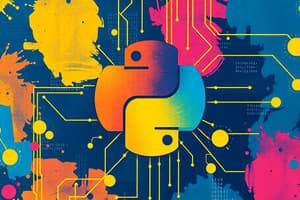Podcast
Questions and Answers
What can be inferred about Python's community support?
What can be inferred about Python's community support?
- It lacks resources and frameworks.
- It is large and active, providing numerous resources. (correct)
- It is only focused on data science.
- It is only accessible through paid services.
Which programming paradigms does Python support?
Which programming paradigms does Python support?
- Only procedural and functional programming.
- Only object-oriented programming.
- Procedural, object-oriented, and functional programming. (correct)
- Text-based and visual programming.
What does the def keyword indicate in Python?
What does the def keyword indicate in Python?
- The definition of a function. (correct)
- The start of a class.
- The declaration of a global variable.
- The initialization of a variable.
Which of the following is true regarding Python's error handling?
Which of the following is true regarding Python's error handling?
What type of collection is a Python tuple?
What type of collection is a Python tuple?
Which of the following is a characteristic of Python's syntax?
Which of the following is a characteristic of Python's syntax?
What is the main reason for Python's compatibility across various operating systems?
What is the main reason for Python's compatibility across various operating systems?
Which of the following libraries is NOT typically associated with Python's data science applications?
Which of the following libraries is NOT typically associated with Python's data science applications?
Study Notes
Overview
- Python is a high-level, interpreted programming language known for its readability and simplicity.
- Released in 1991 by Guido van Rossum.
- Supports multiple programming paradigms: procedural, object-oriented, and functional.
Features
- Readable Syntax: Clean and easy-to-understand code structure.
- Dynamic Typing: Variables do not require explicit declaration; type is determined at runtime.
- Extensive Libraries: Offers a wide range of standard libraries and third-party modules for various applications.
- Cross-Platform: Compatible with various operating systems (Windows, macOS, Linux).
- Community Support: Large and active community; numerous resources and frameworks available.
Basic Syntax
- Variables: Assigned using
=, e.g.x = 5. - Data Types:
- Numbers: int, float, complex
- Strings:
strtype with single or double quotes - Lists: Ordered, mutable collections, e.g.
my_list = [1, 2, 3] - Tuples: Ordered, immutable collections, e.g.
my_tuple = (1, 2, 3) - Dictionaries: Key-value pairs, e.g.
my_dict = {'key': 'value'}
- Control Structures:
- Conditional Statements:
if,elif,else - Loops:
forandwhile
- Conditional Statements:
Functions
- Defined using the
defkeyword. - Supports default arguments and variable-length arguments.
- Example:
def my_function(param1, param2=default_value): return param1 + param2
Object-Oriented Programming
- Supports classes and inheritance.
- Encapsulation of data and methods.
- Example:
class MyClass: def __init__(self, value): self.value = value def display(self): print(self.value)
Error Handling
- Uses
try,except,finallyblocks for exception handling. - Ensures graceful error recovery.
Popular Libraries and Frameworks
- Data Science:
- Pandas (data manipulation)
- NumPy (numerical computing)
- Matplotlib (data visualization)
- Web Development:
- Django (full-stack framework)
- Flask (micro-framework)
- Machine Learning:
- TensorFlow
- scikit-learn
Development Environment
- Interactive environments: Jupyter Notebooks, IPython.
- Common IDEs: PyCharm, Visual Studio Code, Spyder.
Versioning
- Currently, Python 3 is the main version in use, with Python 2 support officially ended in January 2020.
- Key differences include print function, integer division, and Unicode support.
Conclusion
- Python's versatility makes it suitable for various applications including web development, automation, data analysis, machine learning, and more.
Python Overview
- Created by Guido van Rossum and first released in 1991.
- High-level, interpreted language emphasizing readability.
- Supports procedural, object-oriented, and functional programming paradigms.
Key Features
- Clean syntax for easy code understanding.
- Dynamic typing: Variable types are checked during runtime, not beforehand.
- Extensive libraries and third-party modules for diverse applications.
- Cross-platform compatibility (Windows, macOS, Linux).
- Large, active community providing ample support and resources.
Basic Syntax and Data Structures
- Variable assignment uses the
=operator (e.g.,x = 5). - Core data types include: integers (
int), floating-point numbers (float), complex numbers (complex), strings (str), lists (ordered, mutable), tuples (ordered, immutable), and dictionaries (key-value pairs). - Control flow uses
if,elif,elsefor conditionals andforandwhilefor loops.
Functions
- Defined using the
defkeyword. - Allow default and variable-length arguments.
- Example:
def my_function(param1, param2=default_value): return param1 + param2
Object-Oriented Programming (OOP)
- Supports classes and inheritance for creating reusable code structures.
- Enables data encapsulation through methods within classes.
- Example: A class
MyClasswith__init__(constructor) anddisplaymethods.
Exception Handling
- Uses
try,except, andfinallyblocks to manage errors gracefully. - Allows for more robust and stable programs by handling potential issues.
Popular Libraries and Frameworks
- Data Science: Pandas (data manipulation), NumPy (numerical computing), Matplotlib (visualization).
- Web Development: Django (full-stack), Flask (micro-framework).
- Machine Learning: TensorFlow, scikit-learn.
Development Environments
- Interactive environments like Jupyter Notebooks and IPython are commonly used.
- Popular IDEs include PyCharm, Visual Studio Code, and Spyder.
Python Versions
- Python 3 is the current standard; support for Python 2 ended in January 2020.
- Key differences between Python 2 and 3 include the
printfunction, integer division behavior, and Unicode handling.
Versatility and Applications
- Python's versatility makes it applicable to web development, scripting/automation, data analysis, machine learning, and many other fields.
Studying That Suits You
Use AI to generate personalized quizzes and flashcards to suit your learning preferences.
Description
Explore the fundamental concepts of Python programming through this quiz. You'll learn about its features, syntax, and data types, suitable for beginners and those looking to refresh their knowledge. Ideal for understanding Python's versatility and community support.




